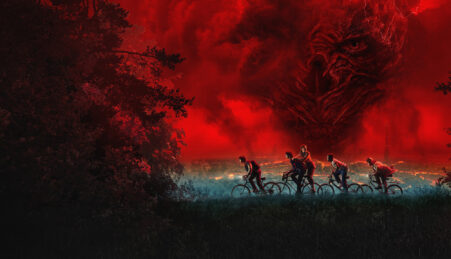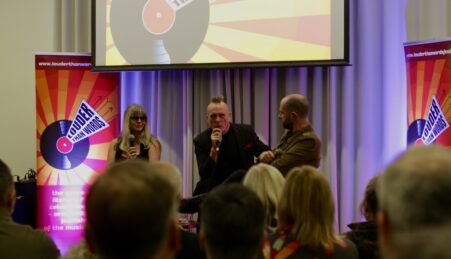The Institute of Humanities and Social Science Research, Monday, 11th February, Geoffrey Manton Building, MMU
Words by Kevin Danson
As part of the Ethical Issues strand of MMU’s Research Institute’s Annual Research Programme, Dr Hannah Smithson and Dr Robert Ralphs, both Senior Lecturers in Criminology at MMU, presented their paper, ‘What’s in it for us?’, which discusses the issues surrounding the current preoccupation with gang culture.
The audience was comprised of students, lecturers, police officers, visitors from the University of Manchester and the University of Bedfordshire, who are working on sexual violence in gangs, and one visitor from London who had been specifically funded to attend this event by the Centre for Mental Health, London. Hannah, whose specialism is in the evaluation in social and criminal justice policy, shared their findings in the second half from the three case studies they were commissioned for, while Rob, who leads research of ethnographic study in youth gangs, opened up the lecture by critically assessing the appropriateness of academic resistance and policy responses to gang culture.
Rob explained that, ‘there has been a lack of research on gangs in the UK that has been explicitly looking at gangs up until the last five or six years’. However, when they applied for their funding to conduct this research in 2004, there had been no research on this topic for around thirty years in the UK. The knowledge we posses in relation to what a gang is, the image we have of one, and its members, comes from, Rob says; ‘the media, police, politicians, ex gang members, criminal memoirs and academic research’, which, as stated, has been lacking.
In the report, ‘Dying to Belong’ (2009), by Chairman of Centre for Social Justice, Iain Duncan Smith, it was stated that 50,000 gang members existed in England and Wales. This is an incredible number, and exactly what Rob justifies to be incorrect with his prime example of Manchester, an appropriate case study in terms of where we are in gang research. With a notorious reputation for gang violence, Manchester has been dubbed ‘Gunchester, Gangchester, Britain’s Bronx’. But how did these names come into existence? There are many factors that play a role in the creation of these etymologies, but the main ones include media representation and an extreme focus on ethnic minorities. After showing results of reports carried out in 2002 and 2012, Rob argues that, ‘within a ten-year period, gang membership has remained the same in Manchester’. Talking us through his calculations of gang members within the leading gang cities in the UK, with room to add on a couple more hundred, the number that is reached continues to remain far below the number stated by Smith.
The definition of what a gang is varies from person to person. For the Home Office, a definition of a gang was: ‘A group of three or more people who have a distinct identity (e.g. a name or badge/emblem) and commit general criminal or anti-social behaviour (ASB) as part of that identity. This group uses (or is reasonably suspected of using) firearms, or threat of firearms, when carrying out these offences’ (TGAP, 2008: 23). One detail Rob brought to our attention is that, in Manchester, ‘one firearm incident a year is attributed to gangs, and the last gang related homicide is four years ago, almost. By that definition, we don’t have a gang problem in Manchester anymore’. Another interesting detail he shared is that now, the Home Office has changed their definition of a gang by removing the focus on firearms.
Hannah revealed the findings of their case study at a place they named ‘Northville’. For protection of identity and location purposes, this name changing is a practice they adopt whenever a fieldwork research project is carried out. This particular research was commissioned by Northville’s Gang Strategy Board, who, according to them, had seen Northville experience gang related crime for a number of years. Nonetheless, the intelligence collected by the two researches revealed that they found something different to this statement.
The three designated areas chosen by the commissioners for research shared some similar characteristics; deprivation, high rate of serious violent crime and assault and its population pertaining largely to BAME (Black, Asian and Minority Ethnic) groups. As their research developed, their concerns grew as they noticed that the chosen areas were predominantly Asian, Muslim areas, forcing them to focus on young Asian men.
Through their data collecting techniques, the information acquired pointed to the fact that Northville did not have the violent gang problem previously stated. While Rob was blending in – hanging around the streets – he got talking to one of the young residents. After telling him about the research he was conducting in the area, he was told, ‘You won’t find any gangs around here. … Drugs yes, gangs no’.
‘Gang speak’ has pervaded society and its use has now become commonplace when referring to a group of young people, especially in a deprived area, though with few or no similarities reflecting the definition of the Home Office. When asking the police about gang presence in Northville, their responses were unequivocal: ‘Northville did have a gang problem’. One officer disclosed; ‘We’ve got gangs, they’re just set-up differently’, while another confirmed; ‘Northville doesn’t have a violent gang problem, but it has a gang problem’. Moreover, when asked, ‘Why were these three predominantly Asian areas chosen?’, one reply was, ‘The problem is there’s so many of them. You wouldn’t get these problems (young people with very little to do, hanging about on the streets) in the white areas. They’re hanging about on streets (or in cars) because they don’t want to be at home’.
One detail that kept recurring amongst their research was the drug-dealing problem in Northville. Hannah highlighted the fact that money from the government was not being distributed to tackling drugs, but to combat gangs. For this reason, the gang problem Northville declared to have, appeared to be a way of them being granted the funds they were unable to receive for the drug problem. This, Hannah argues, is the current climate we find ourselves in within the UK.
The main conclusions I have taken from their research are that; ‘the problems in Northville are set against wider social problems of inequality’, the labeling of gangs has become too indifferent, thus alienating BAME groups and their communities, creating unwarranted marginalisation, stigmitisation and antagonistic relationships with the authorities.
The information provided was interesting in abundance. You can listen to the lecture to get the full story here. Their article that goes more into detail about what they found in Northville, ‘Used and Abused: The Problematic Usage of Gang Terminology in the United Kingdom and Its Implications for Ethnic Minority Youth’ has come out just this month in the British Journal of Criminology (BJC). You can find out more about this article here.
Kevin Danson is an English Literature student at MMU who likes to share his roving ramblings. Read his blog Pebbleddash and follow him on Twitter @pebbleddash






Leave a reply